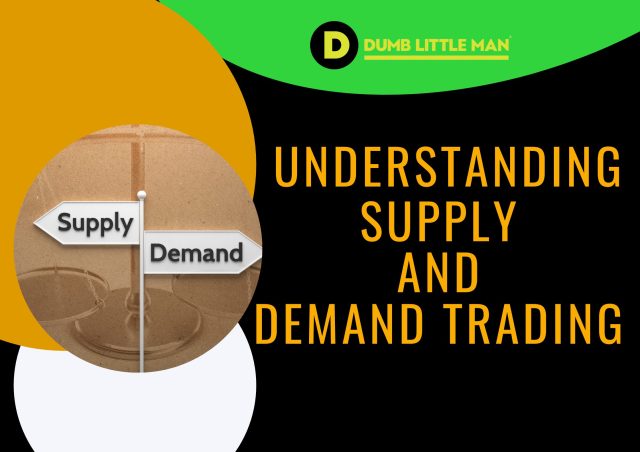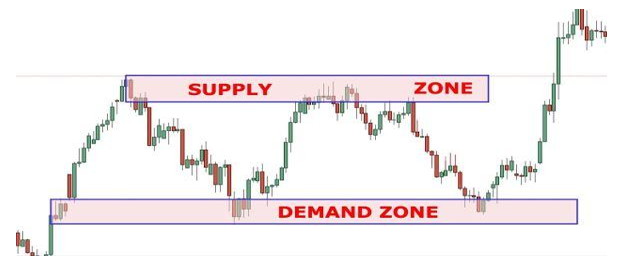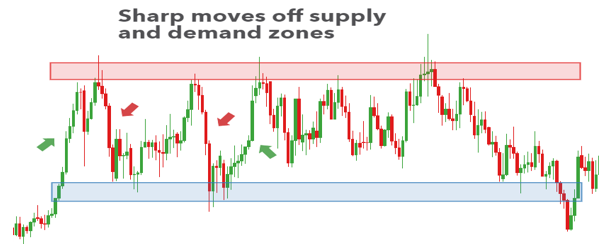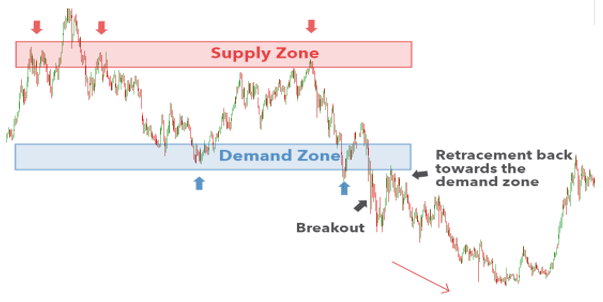Supply and Demand Zones: Forex Trading Strategy

Long-term forex trading is popular among traders who want to hold their trading positions for a long period of time. Helps deal with power.
Additionally, it helps create a defined system with sound risk management practices. This explains why experienced forex traders prefer trading supply and demand.
In a market as complex as the Forex market, there are a myriad of strategies available, and trying to choose one from a multitude of options can be overwhelming.
Using a supply and demand trading strategy creates an excellent foundation for incorporating other trading techniques while providing a deep understanding of the price. But before you start trading supply and demand, it’s important to understand how it works and what the best options are.
Understanding supply and demand trading
The concept of supply and demand is the determinant of price. It is the force behind the forex market and the price movements of any security or tradable asset.
Traders who understand how supply and demand work are well suited to take advantage of current and future price movements in the forex market.
basic principle of Demand and Supply in Forex Trading It states that when demand for a currency pair is high, the price of such assets will rise, resulting in more buyers than sellers. However, when the supply of a currency pair is high, sellers dominate the market and the price of the asset falls.
Demand and supply trading strategies use the most basic principles of the forex market, Easy way for first-time tradersThis strategy aims to highlight zones or areas where traders can make the maximum profit. These zones are formed when the price of an asset finds equilibrium. At some point, even in trending markets, there are periods of relative balance between buyers and sellers that create zones.
There are two zones: supply zone and demand zone. The supple zone is also called the distribution zone and the demand zone is also called the accumulation zone.
The Importance of Zones in Forex Trading

The supply and demand zone is the key area where the price has reached many times. Unlike line-like support and resistance levels, they are very close to zones, hence the name.
When the price of a currency pair hits the supply zone or distribution zone, traders will try to sell the asset. This zone has seen a lot of sharp price movements due to increased selling interest.
Demand zones are the opposite. Here the price starts to fall due to buyer actions. When prices start to fall, most traders wait until they reach a point in the demand zone where they can make the most profit from buying.
These zones are very important as they provide information and opportunities for traders. Traders can determine the forces behind currency rates. They can notice when major players such as hedge funds, governments and institutional investors enter the market to keep prices at certain levels or other levels. Hopefully you can predict when the price will pause or retrace.Additionally, you can combine this strategy with other strategies major forex trading Strategies for finding key zones and trading currency pairs for profit.
How to use demand and supply zones
Before setting your entry and exit points, stop loss and take profit targets, you should:
● Define supply and demand zones
Supply and demand zones can be defined by identifying the points where the price is above or below the bid price. If there is an area where the price appears to rise or fall multiple times, it is a demand zone or a supply zone as the case may be. Additionally, look for areas where prices are fluctuating or consolidating, as this may indicate a balance between supply and demand.
To see these zones, use daily or weekly pivot points, depending on your trading timeframe. Additionally, support and resistance levels can be used to determine these zones. Watch for support and resistance levels along possible supply and demand zones as they highlight the most profitable opportunities.
Fibonacci levels can also be used to increase the accuracy of turning price points in zones. In general, the 61.8% Fibonacci level is the most important Fibonacci level when using supply and demand zones. Technical indicators such as the Relative Strength Index can provide additional confirmation of supply or demand zones. It provides reliable entry or exit signals when potential price reversals coincide with demand or supply zones.

Check the strength of the zone
The strength of a supply or demand zone is determined by the price action within it. A good zone is narrow and price should spend a little time in it.In other words, the less time price stays in the zone, the stronger it is. If the price spends a lot of time inside the supply zone, it is weak.
You can always use the volume indicator to analyze the strength of your zones. By investigating trading volume You can point out and take advantage of areas where high buying and selling pressure exists among assets at different price levels.
Trade breakouts
Supply and demand zones don’t last forever and eventually break after being tested many times. A strong imbalance between buyers and sellers causes explosive price movements, and the stronger the breakout from the zone, the better.

To trade a breakout, open a trade immediately after the price moves beyond the demand or supply zone. However, retracements or pullbacks are still possible and stop loss orders should be placed near one of the zones.
Demand and supply zones are very similar to support and resistance lines, and zones may indicate areas where traders can place stop-loss orders. If the price crosses the supply zone, you should place a stop loss below the zone. However, if the demand zone is breached, a stop loss order will be placed above the zone.
Setting a take profit target after the breakout can be a little more complicated as the price is at a significant level. Therefore, it is recommended to set your take profit after the highest or lowest level of recent price movements.
Conclusion
Every strategy, even as price oriented as a supply and demand trading strategy, has its own advantages and disadvantages. If you are new to the market, trading with this simple long-term strategy will allow you to understand the market well enough to reflect your own performance.
When combined with chart patterns such as the Adam and Eve pattern or one of the many harmonic patterns, you can get a better sense of trends and price movements.
Whichever strategy you use, be sure to consider your needs, experience, and unique circumstances. Also, different markets have different optimal strategies. Some strategies are more effective in trending markets, while others are most effective in ranging or more volatile markets. Choose the best strategy.
Like this article? Subscribe to our feed!
author: dumb little man
At Dumb Little Man, we strive to provide our readers with accurate, high-quality content. We will keep you up to date with the latest news. Articles are fact-checked before publication.
https://www.dumblittleman.com/supply-and-demand-zones-forex-trading-strategy/ Supply and Demand Zones: Forex Trading Strategy




